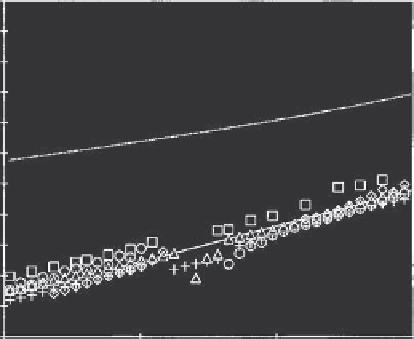Biomedical Engineering Reference
In-Depth Information
1.0E+00
Experimental results: 9.1 wt% Fe
2
O
3
+
U
0
= 0.28 m/s,
W
b,0
= 20 g
∆
1.0E-01
U
0
= 0.19 m/s,
W
b,0
= 20 g
U
0
= 0.15 m/s,
W
b,0
= 20 g
U
0
= 0.19 m/s,
W
b,0
= 10 g
U
0
= 0.19 m/s,
W
b,0
= 30 g
Yagi & Aochi correlation
our correlation
1.0E-02
1.0E-03
1.0E-04
1.0E-05
1.0E-06
1.0E-07
1.0E-08
1.0E-09
1.0E-10
1.0E-11
0.0001
0.001
0.01
0.1
Re
t
FIGURE 12.5
Comparison of the new correlation presented as equation (12.16) with that of
Yagi and Aochi and with experimental results. (From Alvaro et al. 2007.)
12.4.2 Extra Forces or Equations Usually Required When
MSFBs Are Applied in Biotechnology and Medicine
Overall equations as described in the previous sections apply in general terms
to every application of MSFBs. However, for each specific application they
must be complemented by other equations and also by other complementing
support theory.
This is the case of the applications of MSFBs in the areas of biotechnology
and biomedicine, and we will see some of these complementing equations and
theoretical support, in what follows.
In these kind of applications mass transfer is always involved and thus,
equations like the one that regulates the diffusion of a certain compound into
and within a porous magnetic compound forming the bed, must be taken into
account. We may use, for example, the dispersion model, given by
D
ax
∂
2
c
i
∂z
2
∂c
i
∂t
+
u
∂c
i
∂z
−
=
ν
(
c
i
)
(12.18)
which, when applied, justifies mass transfer behavior like the one depicted in
Figure 12.6.
Quite often we must also include in our theoretical analyses complementing
theories and equations that describe chemical or biological reactions and/or
adsorptions, as many applications of MSFBs in the biotechnological and
biomedical areas use a chemical or biological reaction as the main support



Search WWH ::

Custom Search